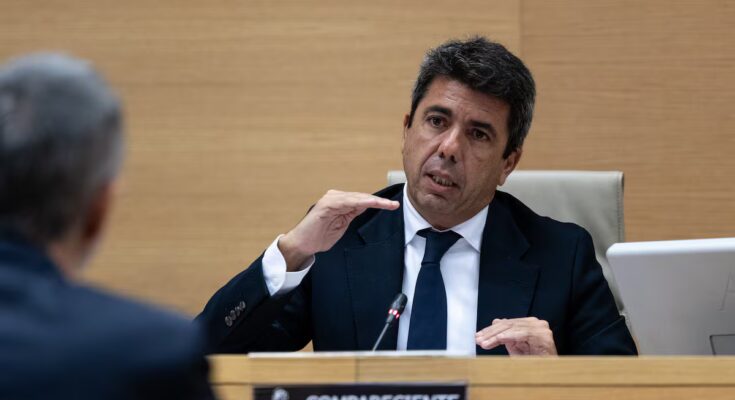The investigations into the damage conducted for more than a year by the magistrate of Catarroja (Valencia), Nuria Ruiz Tobarra – collected in more than 42 summary volumes – cast serious doubts on the speech that the interim president of the Generalitat Valenciana, Carlos Mazón, of the PP, defended in court on Monday Congressional commission of inquiry into Dana of the Deputies.
The judge’s investigation into the 229 deaths caused by the flood was approved in 23 cases by the Provincial Court of Valencia. The proceedings tighten the siege on Mazón and his two senior officials under investigation: the former Minister of Justice and the Interior, Salomé Pradas, and his number two during the disgrace, Emilio Argüeso. The synthesis of the Dana dismantles the skeleton of the defense of the popular baron. Article 502.3 of the penal code provides for prison sentences of six months to one year or a fine of six to twelve months for lying before a parliamentary commission of inquiry. These are the main contradictions:
The information blackout did not exist
Stating to Congress that “we did what we could with the information we had,” Mazón once again alludes to the information blackout theory. A thesis that he has been holding on to for a year and which has been dismantled by the judge in dozens of cases. The idea – vehemently defended by the People’s Party, the two suspects and the PP – argued that if the Valencian executive did not react better and more quickly to the tragedy of October 29, 2024, it was because organizations of Pedro Sánchez’s government, such as the Hydrographic Confederation of Júcar (CHJ) or the State Meteorological Agency (Aemet), did not inform in advance of the size of the waterspout. The judge endorsed the declarations of the top representatives of these institutions, who during their appearance as witnesses declared that they had reported the risk days in advance. And on the same day they reported its severity. The Aemet, for example, declared a red alert for heavy rain, the maximum on the scale, at 7.36am on the 29th. Sources from the Ministry of Ecological Transition assure that “at no time was the transmission of hydrological data interrupted nor was public access to the information blocked” and that the Automatic Hydrological Information System “remained operational during the episode”.
To deny the information blackout, the judge also underlined in dozens of resolutions that the competence in the management and prevention of the tragedy was autonomous, as stated in the Statute of Autonomy.
Furthermore, the Generalitat also had first-hand information on the evolution of the disaster in real time. 112, the regional emergency switchboard, received almost 20,000 calls on October 29 and was able to act as a risk gauge.
The first death occurred in the morning
Mazón claimed that “nothing was known about the first loss of life until five in the morning” the day after the catastrophe. But, according to the report, at 11:45 am on October 29, 2024, truck driver José Hernaiz was no longer answering his phone. Hernaiz is the first fatal victim of the Dana. At 1pm there were 4,459 emergency calls asking for help. Between 1pm and 4.59pm, 10 deaths were recorded. When Carlos Mazón’s manager sent the alarm on his cell phone, at 8.11pm. on October 29, 2024, at least 156 people had already died and another 37 were in a critical situation.
THE former councilor Salomé Pradas decided to call the Cecopi around 3pm. that Tuesday. Pradas schedules the meeting for 5 p.m. just when a few minutes before 3pm he learns of the first missing person in L’Alcúdia, who is Hernaiz himself. Mazón and Pradas speak for two minutes at 5.37pm, for the first time that day, and seven minutes at 6.16pm. They will speak five more times shortly before sending the alert.
When Cecopi (Integrated Operational Coordination Center) left at 5pm, a dozen people had already died. And at least 56 when President Carlos Mazón finished his meal at the El Ventorro restaurant with a journalist at 6.45pm.
Mazón gave no explanation
Him president In Parliament he claimed to have been “the only one to give explanations”. However, some data about what Mazón did during the biggest natural disaster of the century took more than a year to become known, some keys are still unknown (the politician’s path or the content of his conversations). And others have become known thanks to the requests of the judge of Catarroja. Meanwhile, the popular man and the journalist who knew the details of the mysterious afternoon changed their story up to three times.
After defending for four months “that he had arrived at Cecopi after 7pm”, last February the Generalitat released an image from the security camera of the building in L’Eliana (Valencia) where the crisis was coordinated, which showed that the president had entered the center at 8.28pm.
Another of the great unknowns, the length of time Mazón remained in El Ventorro, also underwent three changes. Journalist Maribel Vilaplana said in November 2024 that she said goodbye to Mazón at 5.45pm. She later corrected herself in an open letter and said an hour had passed. And finally, after learning that the magistrate was citing her as a witness – a condition that forced her to tell the truth – it transpired that president He accompanied her to the parking lot where she had her car. The judge allowed Vilaplana not to refer to these changes during his court appearance, arguing that they occurred before the court summons.
Yes, there was information about the risk of the Poyo ravine
Contrary to what Mazón defended in Congress, the Generalitat was informed of the danger of this avenue a few hours before the Poyo ravine overflowed. After 12:00, the Ministry of Justice and Interior decrees the hydrological alert for Poyo, according to a video included in the summary of the center of L’Eliana (Valencia) which shows the former councilor Pradas writing this danger in a document. Furthermore, the Generalitat, through 112 – the emergency switchboard – learned of the overflowing of this avenue at Chiva and Cheste after 4.40pm. due to the dozens of calls warning of danger coming from these locations. Another indicator: the former number two of the Generalitat Emergencies, the accused Emilio Argüeso, wrote at 2.44pm. in a chat with senior officials of the Generalitat who contributed to the cause: “The ravines are about to collapse.”
Apart from the e-mail sent by the Júcar Hydrographic Confederation, to L’Eliana, where 112 calls are centralized and Cecopi meets, the flow of the ravines is displayed on screens that update every few minutes. And they are available in real time to workers.
ES-Alert: a protocol that existed
Mazón stated that “the ES-Alert protocol does not exist”, but the Generalitat Valenciana was contemplating in August 2024 the use of the ES-Alert system to alert the population in case of emergency. He shared in a document with the municipalities that “since this year the population alert system (ES-Alert) has been active through the National Alert Network, which allows messages to be sent to mobile phones in particularly serious situations and which involve actions on the part of the recipients”.
Return with the dead
Presenting himself at the Congress of Deputies, Mazón – who had the obligation to tell the truth – assured that he learned of the number of deaths caused by the flood at five in the morning the day after the flood. However, he himself, at 0.35 am on the day of the tragedy, appearing in the building where Cecopi was detained in L’Eliana (Valencia), acknowledged that “there were lifeless bodies”. “We can already confirm that lifeless bodies have been found. Out of respect for the families, for now, we will not give further information. We must therefore send them a message of calm. We know that it is difficult, of patience and strength”, acknowledged the popular baron flanked by his then advisor Salomé Pradas and the deputy director general of Emergencies, Jorge Suárez.



